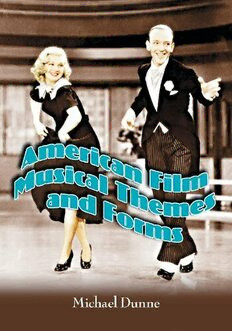
American Film Musical Themes and Forms PDF
Preview American Film Musical Themes and Forms
American Film Musical Themes and Forms American Film Musical Themes and Forms M D ICHAEL UNNE McFarland & Company, Inc., Publishers Jefferson, North Carolina, and London LIBRARYOFCONGRESSONLINECATALOG Dunne, Michael, ¡94¡– American film musical themes and forms / Michael Dunne. p. cm. Includes bibliographical references and index. ISBN-¡3: 978-0-7864-1877-0 (softcover : 50# alkaline paper) ¡. Musical films—United States—History and criticism. I. Title. PN¡995.9.M86D86 2004 79¡.43'6—dc22 20040¡2¡2¡ British Library cataloguing data are available ©2004 Michael Dunne. All rights reserved No part ofthis book may be reproduced or transmitted in any form or by any means, electronic or mechanical, including photocopying or recording, or by any information storage and retrieval system, without permission in writing from the publisher. On the front cover:Ginger Rogers and Fred Astaire perform “Pick YourselfUp” in Swing Time Manufactured in the United States ofAmerica McFarland & Company, Inc., Publishers Box 6¡¡, Je›erson, North Carolina 28640 www.mcfarlandpub.com Acknowledgments While I bear full responsibility for the prejudices, misjudgments and just plain errors that appear in this book, I am grateful to many people who have helped me get into the position to make these ga›es. Numerous college friends attended movies with me decades ago when we should have been going to class. Even though the statute oflimitations has probably run out on these o›enses, I will keep these friends’ names secret just in case. Much more recently, Claudia Barnett, Will Brantley and Pete McCluskey helped me by lending me books when I needed them. Will Brant- ley, Dale Cockrill, Julie Graham, Bob Holtzclaw, Ron Kates, Arthur Knight and David Lavery helped me get hold of videos. Bob Holtzclaw cut out and passed along clip- pings from various periodicals and also coerced me into buying a used copy ofClive Hirschhorn’s invaluable The Hollywood Musical. Paul Wells and the sta› ofthe MTSU Center for Popular Music were, as usual, unfailingly helpful and courteous. Jerry Ohlinger helped me locate stills from many ofthe films I was writing about. The pub- lishers ofJournal ofPopular Film & Televisiongraciously granted permission to revise and reprint material that earlier appeared in their pages. Ray B. Browne provided some helpful and very welcome editorial advice. My wife, Sara, watched countless musicals with me and uncomplainingly listened to Fred Astaire sing (and dance) on vinyl, tape and CD. My gratitude to all ofthese folks, and especially Sara, goes beyond what my words can express. v Table of Contents Acknowledgments v Introduction 1 ¡. Hollywood Musicals and the Depression 13 2. Blackface Minstrelsy in Musicals 34 3. Confronting Rock Culture 52 4. Dance as a Narrative Agent 67 5. American Places and Spaces 87 6. Fred and Gene in Never Never Land 107 7. Musical Biopics 126 8. Intertextual Musicals 147 9. Conclusion: “How About a Nice Musical?” 173 Chapter Notes 187 Works Cited 201 Index 209 vii Introduction In the introduction to their Musicals: Hollywood and Beyond, Bill Marshall and Robynn Stilwell write, “The musical is one of the most popular film genres among both audiences and film scholars, probably for many ofthe same reasons—the spec- tacle, the music, the enjoyable predictability of the outcome weighed against the pleasure ofthe varied details” (¡). Their praise ofthe genre is echoed by many crit- ics, sometimes without even so much acknowledgment ofthe musical’s generic lim- itations as recognizing “the enjoyable predictability ofthe outcome.” Stephen Citron, for example, simply claims in The Musical from the Inside Out that “[t]he musical is the most popular form of entertainment in the world” (¡4). To reach this conclu- sion, Citron considers both stage and screen musicals. Focusing more narrowly on films, Jane Feuer makes an equally sweeping claim in her book The Hollywood Musi- cal. “The musical is Hollywood writ large,” Feuer writes (ix). This is also Liz-Anne Bawden’s point in The Oxford Companion to Film when she writes that “[t]he his- tory ofthe screen musical is essentially that ofthe American musical: the outstand- ing examples of the genre have been made in Hollywood and only the American industry has consistently produced musicals throughout the sound era” (489).Such testimony concerning the musical itself—and in particular the Hollywood version ofthe musical—might lead one to conclude that still another book about Hollywood musicals is warranted. At any rate, such criticism has led me to this conclusion—as has my own enthusiasm for Hollywood musicals. When I was in college, many years ago, there were no videocassettes. Anyone who wanted to see an old movie would have to go to a museum or a revival house. I often went to the latter, to the Thalia and the New Yorker theaters, to see old movies. I saw all of the Marx Brothers’ movies this way and most of W. C. Fields’s. Most impressive to me, however, was the series offilms starring Fred Astaire and Ginger Rogers. I loved those movies when I saw them in a theater in the early ¡960s. I loved them later on when I saw them on television, and I loved them when the technology ofthe videocassette and DVD allowed me to pause, to reverse, to rerun, to appreci- ate every subtlety ofthe performances. Ofcourse, other musicals caught my atten- tion along the way: films starring Gene Kelly, and Judy Garland, and Eleanor Powell, and Alice Faye, and a host ofothers. I also came to relish what the song in Silk Stock- ings (¡957) calls “glorious Technicolor, breath-taking CinemaScope, and stereo- 1
